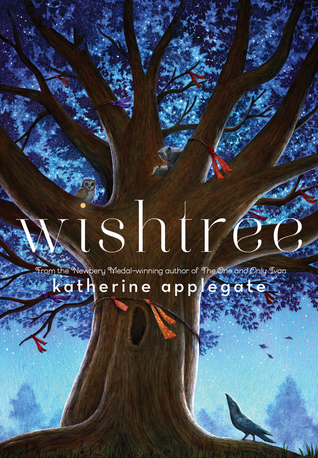 From Goodreads,
From Goodreads,"Trees can't tell jokes, but they can certainly tell stories. . . .
Red is an oak tree who is many rings old. Red is the neighborhood "wishtree"—people write their wishes on pieces of cloth and tie them to Red's branches. Along with her crow friend Bongo and other animals who seek refuge in Red's hollows, this "wishtree" watches over the neighborhood.
You might say Red has seen it all. Until a new family moves in. Not everyone is welcoming, and Red's experiences as a wishtree are more important than ever."
Goodreads - Wishtree
Awards:
- Goodreads Choice Award Nominee for Middle Grade & Children's (2017)
- NCTE Charlotte Huck Award Nominee (2018)
Every town has traditions that have existed for years. Sometimes they are parades, sometimes they are festivals, and sometimes they are just a silly event that takes place one day out of a year. In my hometown we have October Daze which happens typically the first weekend of October. Local businesses and organizations set up booths where you can buy hand crafted goods or delicious greasy food. I have worked at October Daze and I have been a visitor. I have plenty of good memories with friends and family while attending October Daze. Traditions are important and this book really focuses on that.
This book is told from the unique perspective of the tree. Red, the wishtree, is 216 years old and is a part of an important tradition in town. A wishtree is a tree where people write their wishes on a scrap of paper or fabric and tie it to the tree in hopes of their wish coming true. This tradition has been a long and well known tradition in this town, until someone threatens that by vandalizing the tree. One woman, who has a long connection to the tree, must make the decision on if the tradition should continue or if the tree should be cut down for good.
There are so many amazing things I have to say about this book. First I would like to focus on the artwork that was incorporated into the book. The cover of the book was absolutely stunning with vivid and realistic colors. I was honestly pulled in by the cover of this book more than anything. But only once I started reading the book did I realize that there were illustrations throughout the book. Most of the illustrations were leaves or branches, but there were also pictures of the animals that lived in the tree. However, humans were nowhere to be found in the book. I think Applegate chose to do this for a couple reasons. I think she excluded humans so that the reader could visualize themselves in the book, but also because the focus was supposed to be on nature. I think it is great that the focus was on nature because I feel like everywhere is turning into a concrete jungle. We are constantly clearing land to make room for more housing complexes or shopping centers. Most people don't think about the fact that trees put off oxygen for us to survive and they take in our carbon dioxide. Life on earth would cease to exist if we didn't have trees. I love that Applegate focused on the nature aspect of things instead of focusing on the humans.
Another thing I loved in this book was the whole idea of May Day and a wishtree. In this book the wishtree is Red, who is decorated with scraps of fabric and paper one day out of year. People write their wish on these slips of paper and they hang them on the tree in hopes that they will come true. I love this tradition and I honestly wonder if there are any locations in the United States that does this. One of the things that was important about this tradition was where and how it all started. I think that many of our traditions continue without us ever remembering why they started in the first place. Every tradition has a story to it, and I think it is important to hear the story every now and then to remind yourself why you do something. Applegate made sure to include the back story on how and why the May Day wishing event got started.
The only thing that I didn't like about this book was the slightly far fetched idea that trees can talk. (When the tree started talking I definitely thought about Grandmother Willow from Pocahontas.) In the book Red talks to two children and tells them the story of how it became a wishtree. That's a little far fetched and I think it took away from the book a little bit. I think that many children who read this would see this as a magical tree, while it was really just a regular tree. As Red was telling the story it mentioned that we should listen to the tree because it might talk back to us. I took this more as a message of we should listen to the leaves rustling or the critters playing in the trees, instead of listening for the tree to tell its life story.
This book was very interesting and well written. I give it 4 stars and will definitely be including this in my classroom library.
No comments:
Post a Comment